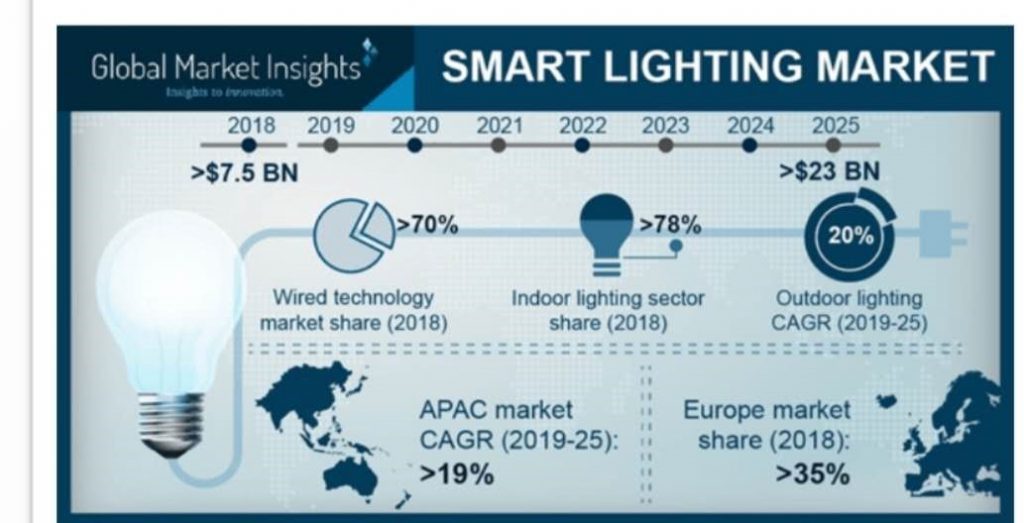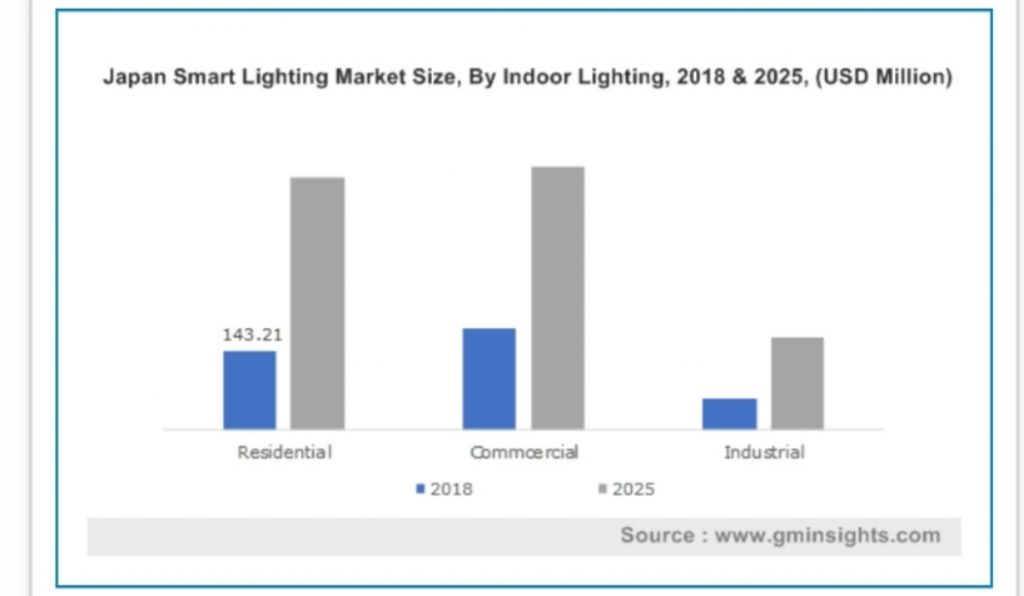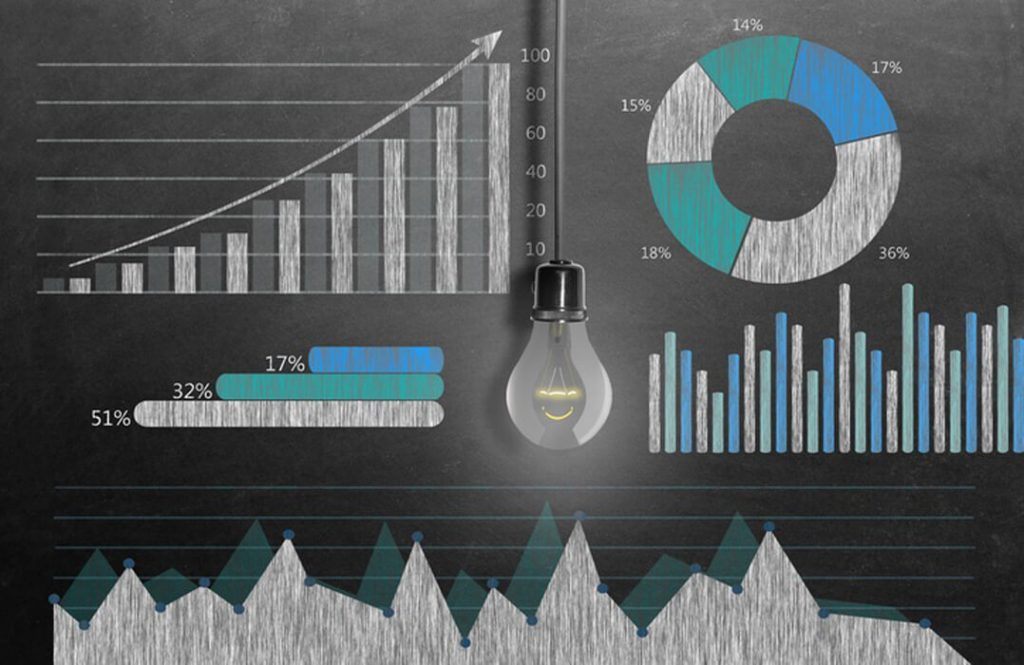Smart Lighting Market size estimated at over USD 7.5 billion in 2018 and is anticipated to grow at a CAGR of more than 15% from 2019 to 2025.

The smart lighting market is driven by stringent government regulations across the globe to restrict the use of inefficient lighting technologies. The government across the globe are constantly working to phase out inefficient lamps such as incandescent and halogen lamps, promoting the use of environmental lighting lamps. Recently, the European Union (EU) announced new regulations to phase out the tungsten halogen and compact fluorescent lamps by 2020. The new regulations under the new Ecodesign Law state that the maximum standby power of 0.5W and a minimum energy requirement of 85 lumens for lamps. This will encourage the sale of more energy-efficient lamps across the region. The government authorities are also offering tax rebates and subsidies to promote the use of more efficient lighting technologies across the globe. This serves as a major driver for the growth of the market.
The rapid surge in the number of smart city development initiatives and investments has further accelerated the adoption of the market. As industrialization and urbanization are increasing, the energy consumption across the cities is also rising. It is estimated that cities account for more than 60% of the world’s energy and lighting alone consumes 19% of the world’s electricity. To reduce energy consumption and effectively manage resources, governments are leveraging on advanced technology solutions to manage assets and resources more effectively. This is encouraging the development of smart city initiatives across the globe, which will aggregate the demand for smart lighting industry.
However, the high cost of smart lighting solutions as compared to traditional lighting alternatives is acting as a major constraint in the smart lighting market growth. Moreover, the security issues associated with the use of connected lighting and smart lighting systems will also hinder market growth.
By Component
Hardware is leading the component landscape with more than 80% share in the smart lighting market in 2018. The growth of the market is attributed to the wide adoption of smart bulbs and connected luminaire among residential & commercial sectors. The integration of advanced technologies, such as Bluetooth, ZigBee, and Wi-Fi, into lighting solutions is one of the major factors driving the market growth. This allows the smart bulb to be controlled through mobile apps or home/building automation hubs and individual bulbs can be programmed to change the output as per the requirements. Moreover, the cost-effective nature and the energy efficiency of smart bulbs are augmenting their demand in the market. It is expected that the more than 250 million-unit smart bulbs will be sold by 2025.
The software market will grow at a CAGR of more than 22% during the forecast timeline. The market is driven by the growing adoption of smart home and business automation solutions across the globe. Over the past five years, there has been a sudden increase in the integration of the IoT devices into residential & commercial sectors. The consumers are using connected devices to reduce energy consumption and remotely manage their appliances from remote locations. This software allows users to control the intensity of lamps and luminaires as per the infrastructure, ambiance, and intensity of the light. Moreover, the advent of lighting as a service solution along with the proliferation of mobile apps to control the lighting is also serving as a major driver for the growth of the software market.
Wired technology captures the major share in the smart lighting market, accounting for more than 70% in 2018. The growth of the market is attributed to the increasing adoption of wired communication technology in the outdoor lighting space. The robust nature of the wired technology along with high reliability and control over the lighting solutions makes it an ideal solution for outdoor lighting applications. The large-scale adoption of the PLC technology in the outdoor lighting application and DALI in indoor lighting application also helps the market to grow. The superior properties, such as susceptibility to electromagnetic interference and high reliability in extreme environmental conditions, also fuel the demand for the technology. However, the inflexibility and limited extensibility of the wired solution act as major constraints in the growth of the market.
The wireless technology will grow at a CAGR of more than 21% during the forecast period. The growth of the market is driven by the growing adoption of wireless connectivity for lighting applications. The lighting manufacturers are shifting from traditional lighting control protocols to sophisticated wireless lighting control systems. Wireless technology offers a natural grid for connectivity and enhances operational efficiency and assists in developing new business avenues. The wireless technology also offers multiple benefits as compared to the traditional wired technology including flexibility, cost-effective, easy to install, and security, augmenting its demand in the commercial and residential market space.
Indoor lighting accounts for over 78% share in the smart lighting market. The growth of the market is credited to the growing demand for energy-efficient lighting solutions across residential and commercial sectors. The businesses and homes are leveraging smart lighting solutions to reduce energy consumption as it saves energy by using need-based light management systems. The systems detect and collect real-time data about the occupants, light-field sensing, and sunlight to optimize the required light output. The product also enable indoor navigation that enables directional access and improves information in high-traffic buildings.
Outdoor lighting will grow at a CAGR of approximately 20% during the projection timeline. The growth of the market is driven by the growing smart city development initiatives across the globe. The smart lighting solutions are widely used across highways & roadways, bridges & tunnels, and public places to reduce energy consumption. The rising need among the government authorities to optimize the use of energy and remotely manage lighting resources has further accelerated the adoption of the industry.

Europe is dominating the smart lighting market with over 35% share in 2018. The stringent government regulations in the region restrict the use of inefficient lighting technologies. The government in the region has announced a multiple phase-out plan for inefficient lamps. Moreover, the governments in the region have also promoted the use of LED lamps by conducting free distribution of LED lamps along with tax rebates and subsidies. This is encouraging the adoption of the market in the region. The smart city development initiatives in the region along with the stable macroeconomic condition in the region will foster the market growth.
Asia Pacific will grow to attain an annual growth rate of more than 19% during the forecast period. The growth of the market is attributed to the large-scale adoption of LED lamps in the region. The decline in the price of LED lamps along with supportive government initiatives is the major factor acting as a catalyst in aggregating the demand for LED lamps in the region. The growing adoption of smart & connected lamps in the region is developing numerous opportunities for market growth. The increasing industrialization and urbanization in the region will also drive the demand for smart lighting.
Competitive Market Share
The key vendors in the smart lighting market are Philips Lighting, Osram, GE Lighting, Cree, Schneider Electric, Echelon Corporation, Acuity Brands, Silver Spring Networks, Deako, and Tvilight. These players are leveraging both organic and inorganic growth strategies to gain market share and strengthen their position in the market. New product developments are the most commonly used strategies among market players. The companies are constantly working on enhancing their product capabilities and features with the integration of advanced technologies and wireless connectivity. Companies are also focusing on strategic alliances to expand their customer base and global footprints.
Industry Background
Smart lighting has emerged as one of the most disruptive technologies over the past five years. Advanced LED lights are offering a significant bottom-line saving in terms of energy costs. These units are being offered by companies as a part of IoT systems for enabling highly connected infrastructure. This provides users with extra control to effectively manage smart lighting systems. With cheaper & smarter lights rapidly replacing Compact Fluorescent Lamps (CFL) and incandescent bulbs, smart and connected digital lighting using IoT is expected to bring an excellent intelligence and functionality into lighting systems.
Frequently Asked Questions (FAQ) :
1.What are growth estimations for Asia Pacific smart lighting market?
According to the analysts at GMI, Asia Pacific industry will attain an annual growth rate of more than 19% during the forecast period.
2.How much will be the demand for outdoor smart lighting products in coming years?
Outdoor lighting segment will grow at a CAGR of approx. 20% till 2025 as growing public infrastructure development is creating the need for lighting solutions across areas like bridges, tunnels, and roadways & highways.
3.Which smart lighting component is expected to record higher demand?
Residential and commercial sectors are widely adopting connected luminaire and smart bulbs that can be programmed to alter the output as per need, inducing the demand for robust hardware components.
4.Why is wired connection technology ideal for outdoor smart lighting applications?
A wired connection is strong and offers high control and reliability over the lighting solutions in case of unavailability of internet, making it ideal for deployment in outdoor lighting applications.


